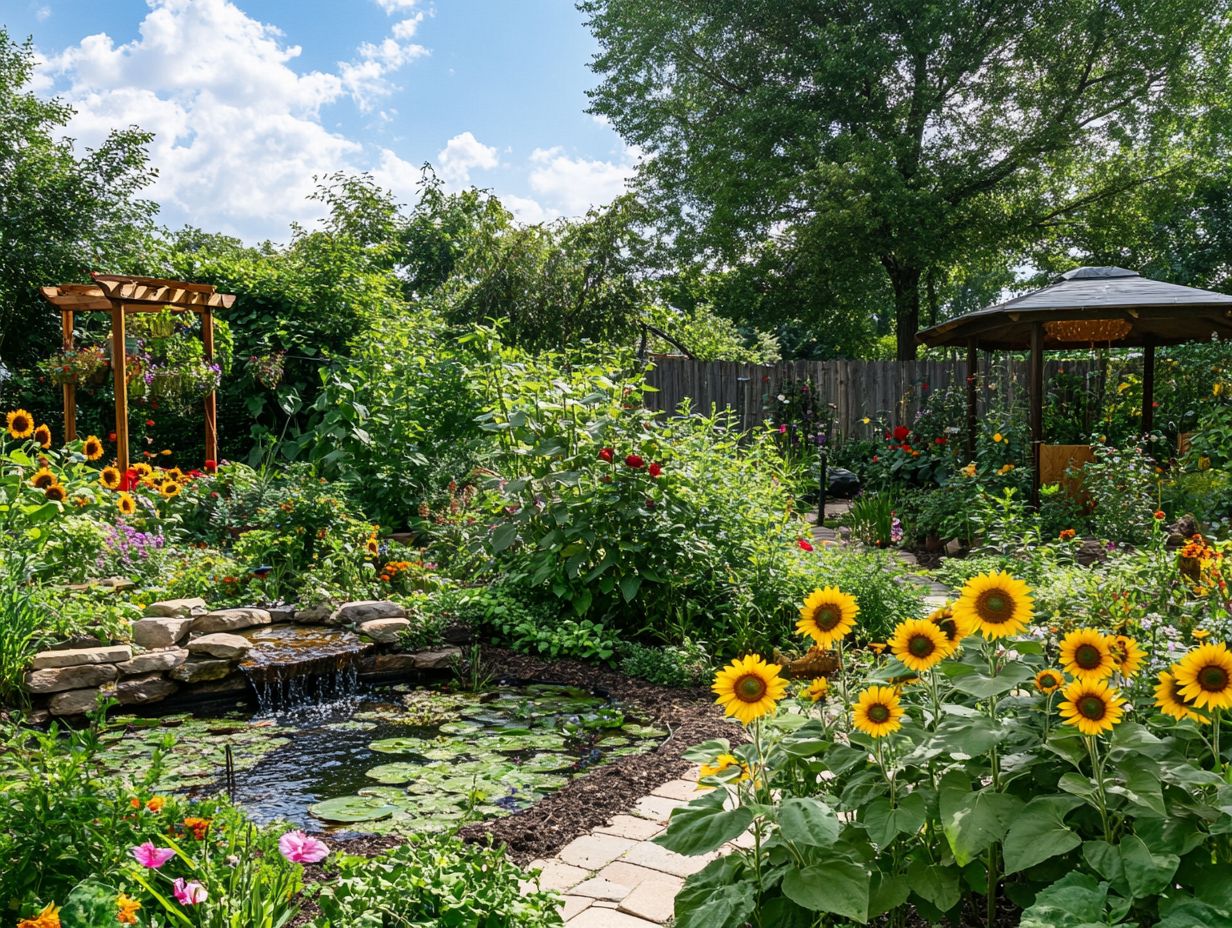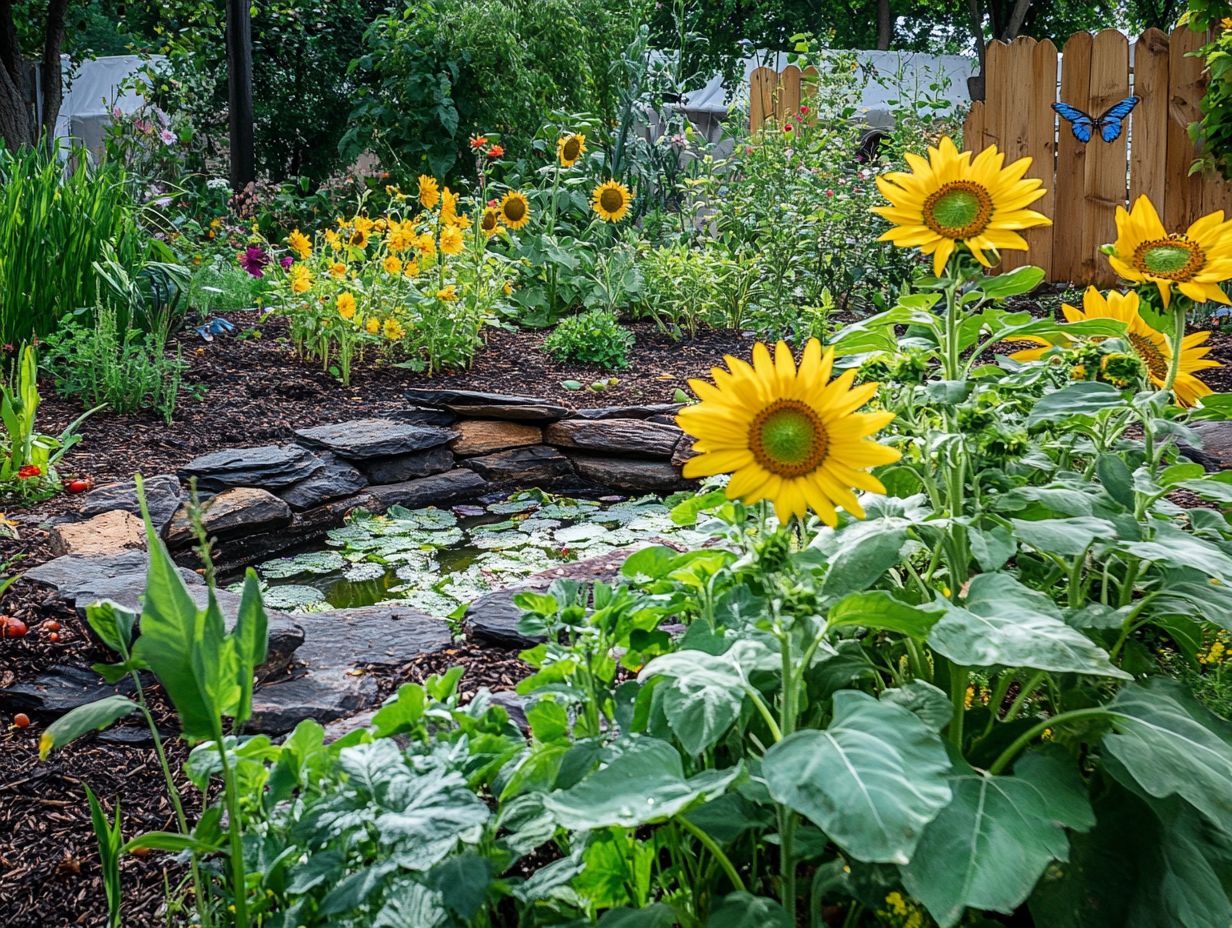The Role of Plants in Permaculture Design
Permaculture transcends a mere gardening method; it embodies a holistic approach to cultivating sustainable ecosystems. At its core, plants play a pivotal role, enhancing biodiversity and providing essential resources for humans and wildlife.
Get ready to explore the myriad ways plants benefit the ecosystem, the design principles for thoughtful plant selection, and the diverse varieties that thrive in permaculture systems. Dive in to discover practical techniques and compelling examples illustrating the profound impact plants have in nurturing a resilient and productive environment.
Contents
- Key Takeaways:
- The Importance of Plants in Permaculture
- Designing with Plants in Mind
- Types of Plants Used in Permaculture
- Implementing Plant-based Techniques in Permaculture
- Integrating Plants into Water Management Systems
- Frequently Asked Questions
- What is the role of plants in permaculture design?
- How do plants contribute to soil health in permaculture design?
- What are some ways plants can be used in permaculture design for food production?
- What is the importance of incorporating native plants in permaculture design?
- How do plants contribute to ecosystem resilience in permaculture design?
- What are some key considerations to keep in mind when selecting plants for permaculture design?
Key Takeaways:

- Plants are essential in permaculture, providing numerous benefits to the ecosystem while serving as sustainable resources for humans.
- When designing with plants, consider climate, soil, and biodiversity to create a successful and resilient system.
- A variety of plants, including edible and companion plants, can create polycultures that support the ecosystem and fulfill human needs.
What is Permaculture?
Permaculture offers a holistic approach to agriculture and land management, designed to create sustainable ecosystems by mimicking natural processes. It emphasizes the intricate connections among plants, animals, soil, and water, all aimed at cultivating an environment that supports diverse forms of life while meeting food and resource needs.
Use principles like diversity and efficient resource use to enhance biodiversity and ecological balance in rural and urban landscapes. Rooted in concepts developed by pioneers like Bill Mollison and David Holmgren in the 1970s, permaculture blends ethical considerations with practical techniques. Its foundational ethics earth care, people care, and fair share serve as guiding principles for sustainable living.
One key benefit is improved soil health through organic composting and crop rotation, methods that enrich soil biodiversity. Additionally, permaculture promotes strategies to manage ecosystems effectively, creating habitats for beneficial insects that play crucial roles in pollination and pest control. Start adopting these sustainable practices today for a better tomorrow!
The Importance of Plants in Permaculture
Plants are integral to permaculture systems, serving as the cornerstone for a diverse and sustainable environment that fosters ecological balance and resilience. Utilizing indigenous plants in permaculture design can enhance these benefits, providing vital food sources like vegetables, herbs, and fruits, while also improving soil health through organic matter and cover crops.
By carefully selecting the right plant species especially native and nitrogen-fixing varieties you can create a flourishing ecosystem that supports beneficial insects and a rich array of wildlife.
How Plants Benefit the Ecosystem
Plants are fundamental to ecosystem health. They provide essential services like nutrient cycling, habitat creation, and pest control. Through photosynthesis, they produce oxygen and organic matter, nourishing soil microorganisms and boosting soil fertility. In permaculture, a diverse array of plant species creates habitats for beneficial insects and wildlife, fostering biodiversity and enhancing ecological resilience.
Take the Eastern Hemlock, for example. It provides shade and shelter while supporting many microorganisms thriving in its nutrient-rich litter. The black locust is renowned for enriching soil with nitrogen, promoting healthier growth in surrounding plants.
These interactions between specific plants and their associated fauna highlight how flora can be natural allies in cultivating thriving ecosystems. Establishing diverse plant communities significantly contributes to improved soil quality and enhanced habitats, attracting pollinators and predatory insects that keep pest populations in check.
Plants as a Sustainable Resource
In permaculture, plants are not just a source of food; they are essential for maintaining ecological balance and fostering biodiversity. By integrating a diverse array of plant species, you can significantly enhance the resilience of your systems, as outlined in the article on the role of biodiversity in permaculture.
Including both annual and perennial crops ensures a steady supply of nutrients and food. Employing cover crops and companion planting techniques optimizes yield, bolsters soil health, and helps prevent erosion while minimizing reliance on chemical fertilizers.
For instance, consider planting tomatoes alongside garlic. This illustrates the powerful synergy that emerges when various species are cultivated together. Tomatoes gain protection from pests thanks to garlic’s natural repelling properties. Meanwhile, garlic flourishes in the nutrient-rich soil that tomatoes help create.
Such strategies not only contribute to a healthier environment but also promote the buildup of organic matter. This enhances soil fertility further. Crop rotation is another vital technique, allowing you to alternate different crops to prevent nutrient depletion and disrupt pest cycles.
By embracing these methods, sustainable agriculture evolves into a vibrant ecosystem, championing both productivity and environmental stewardship.
Designing with Plants in Mind

Designing a permaculture garden with a focus on plant selection requires a thoughtful approach. For a deeper insight, understanding the permaculture design process is essential. Choose species that enhance biodiversity, boost soil fertility, and support ecosystem sustainability.
As you embark on this journey, consider factors like climate, soil type, and the intricate relationships among various plants. This way, you ll cultivate an environment that nurtures both human needs and wildlife.
Incorporating edible plants, herbs, and native species creates a thriving ecosystem that provides food and resources while fostering a harmonious ecological balance.
Key Factors to Consider
When designing a permaculture system, consider several key factors, including the role of swales in permaculture design, to ensure your plants thrive and contribute positively to the ecosystem.
Understanding soil health, water management practices, and the interactions between different plants are essential elements in this process. Assess your site’s conditions and select the right plant species trees, shrubs, and vegetables.
Healthy soil serves as the foundation for all plant life. Soil rich in organic matter improves structure and provides essential nutrients, allowing plants to establish robust root systems.
Implement effective water management strategies, like swales (shallow ditches to manage water) or rain gardens, to enhance moisture retention and prevent soil erosion. Fostering dynamic relationships through companion planting creates beneficial interactions that promote biodiversity and overall garden health.
By emphasizing these elements, you support plant growth and nurture a thriving ecosystem resilient to pests and environmental changes.
Types of Plants Used in Permaculture
Permaculture embraces a rich tapestry of plant varieties, each playing a crucial role within the ecosystem. From nourishing food sources like vegetables and fruit trees to enhancing soil health, these plants work in harmony to support human sustenance and environmental vitality, guided by understanding permaculture design principles.
Native species are essential for preserving local biodiversity. By understanding the functions of different plants and recognizing potential threats posed by invasive species, you can cultivate a balanced and sustainable permaculture system that thrives.
Embrace these principles and start your own permaculture project today! Explore local plant varieties and contribute to a sustainable future.
Edible Plants
Edible plants are essential for permaculture systems, providing vital nutrients and food sources. By adding vibrant vegetables like zucchini and tomatoes, along with fruit-bearing trees, you can create a resilient food system.
Establishing food forests with layered edible plants boosts productivity and offers sustainable nourishment. These systems enhance food security and support local biodiversity by attracting various pollinators and microorganisms.
For example, planting nitrogen-fixing plants like peas with berry bushes improves soil health and provides a delightful variety of foods. Adding herbs like basil and mint can transform your culinary experiences and attract beneficial insects that control pests.
The diverse communities of edible plants create a balanced ecosystem, leading to healthier environments and better nutrition for everyone.
Companion Plants
Companion planting pairs plants to boost biodiversity and improve ecosystem health. Choose plants that naturally support each other to manage pests, enhance soil health, and optimize nutrient uptake.
For example, planting garlic with your vegetables deters harmful insects and benefits the overall garden. The classic combination of tomatoes and basil not only enhances flavor but also repels pests like aphids and whiteflies.
Marigolds act as a natural barrier against nematodes and other garden pests, reducing the need for chemical pesticides. These plant relationships enhance pest control and enrich soil through synergistic interactions of their root systems.
Implementing Plant-based Techniques in Permaculture

Implementing plant-based techniques is crucial for creating productive ecosystems that thrive on biodiversity. These techniques include integrating diverse plant species, practicing crop rotation, and establishing effective water management systems.
Nurturing food forests and using innovative planting strategies support both plant growth and community well-being. What will you create in your permaculture garden?
Examples of Plant Guilds and Polycultures
Plant guilds and polycultures are effective permaculture techniques that group plants to create beneficial relationships and enhance biodiversity. Thoughtfully combining different species optimizes growth and boosts resilience to pests.
Imagine a guild with a fruit tree, nitrogen-fixing legumes, and dynamic accumulators. This mix enriches the soil and nurtures a vibrant micro-ecosystem. In a well-crafted polyculture, plants share resources like sunlight and water, naturally deterring pests through competition.
For example, pairing tomatoes with basil not only enhances flavor but also helps control pests. Adding a ground cover crop prevents soil erosion and improves moisture retention.
These combinations highlight the impact of biodiversity on soil health. Healthy soils support vigorous plant communities, creating a sustainable, productive environment.
Integrating Plants into Water Management Systems
Integrating plants into water management systems is a crucial component of permaculture. This practice significantly enhances soil health and promotes biodiversity. By selecting the right plant species that thrive in wet conditions or help stabilize soil, you can create effective systems for sustainably managing water resources, aligning with the essential elements for a permaculture design.
Techniques such as rain gardens and swales leverage plants for natural filtration and water retention. These methods yield benefits for both the ecosystem and agricultural productivity.
For example, incorporating native wetland plants like cattails and bulrushes dramatically boosts nutrient cycling and provides habitats for diverse wildlife. Additionally, using cover crops like clover and alfalfa enhances soil structure and aids in water infiltration, which helps to reduce runoff.
Frequently Asked Questions
What is the role of plants in permaculture design?
Plants are central to permaculture design, serving as the cornerstone of sustainable food production, soil health, and ecosystem resilience.
How do plants contribute to soil health in permaculture design?

Plants provide essential nutrients to the soil through their root systems. They improve soil structure through growth and decomposition, while increasing microbial activity in the soil.
What are some ways plants can be used in permaculture design for food production?
In permaculture design, plants can be utilized for food production through techniques such as polycultures, crop rotation, agroforestry, and companion planting. Understanding the role of fungi in permaculture can also enhance these practices.
What is the importance of incorporating native plants in permaculture design?
Native plants are adapted to local climate and soil conditions. This makes them more resilient and low-maintenance in permaculture design. They also support local biodiversity and provide habitats for beneficial insects and animals.
How do plants contribute to ecosystem resilience in permaculture design?
Plants help regulate temperature, prevent erosion, and purify water. This creates a more stable and sustainable ecosystem. They also support pollinators and other beneficial organisms.
What are some key considerations to keep in mind when selecting plants for permaculture design?
When selecting plants for permaculture design, consider their compatibility with other plants. Look for plants that provide multiple functions, such as food, shelter, or soil improvement. Additionally, understanding the significance of water in permaculture design is crucial, as you should also assess their specific needs for sunlight, water, and nutrients.






